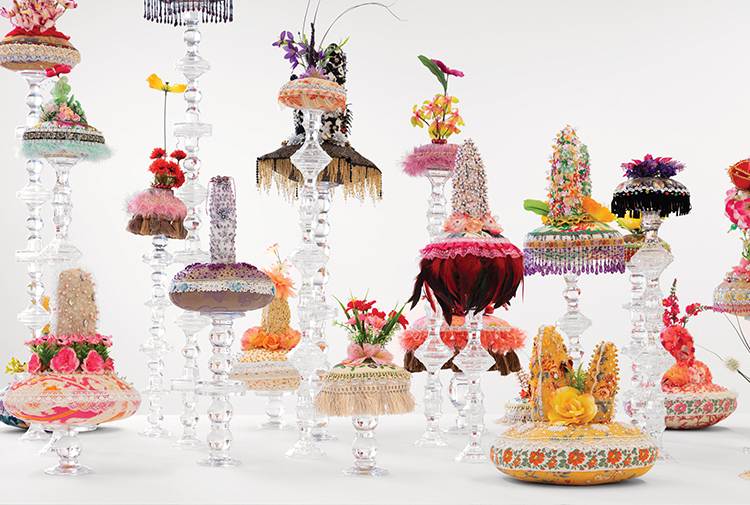After Ange Altenhofen’s cat died, the Chariton native couldn’t bear to throw out the chair the pet had used as a scratching post. So Altenhofen turned it into a sculpture, tucking gemstones into the tattered stuffing to symbolize the value of well-worn objects and what hides within them, beneath the surface. She started to think of the cat as a co-creator, another sculptor who had worked with the materials through repetitive scratching. When the artist identified herself as “a ‘crazy cat lady,’ my ears perked right up,” said Burkhalter, the curator, who shares a fondness for cats. “As Ange put it, sometimes it’s hard to live with other living beings. Sometimes they communicate in ways that can be difficult to process or accept, but when you love someone and are forced to live with them, you adapt.”
 Ange Altenhofen (American, born 1966)
Ange Altenhofen (American, born 1966)
“Wingback 2”, 2023. Deconstructed and reconfigured wingback chair distressed by housecats; gold leaf; natural gemstones including ruby, amethyst, topaz, garnet, citrine, peridot, and black diamond; plastic clay matrix. 40 × 36 × 4 inches. Photos courtesy the artist. (Pictured above and to the right.)
Writer: Michael Morain
Is a throw pillow a piece of art? What about a lamp or a footstool?
For decades, traditional (and usually sexist) notions about the things that make a house a home have kept most domestic items out of art museums. But a new stunner of a show at the Des Moines Art Center tosses those distinctions right out the curtained window. With a dozen beautiful and thought-provoking works by 10 leading artists, including two Iowans, “Transform Any Room” raises fascinating questions about all the stuff that surrounds us every day, whether it’s “art” or “craft,” made by hand or mass-produced.
Senior curator Laura Burkhalter started dreaming up the show several years ago after overhearing Art Center visitors’ comments about a sculpture Nick Cave had assembled from hundreds of familiar trinkets — cologne bottles, decorative tchotchkes, artificial flowers and more. People recognized knickknacks from Dad’s medicine cabinet or Grandma’s hutch.
From there, Burkhalter compiled a list of other contemporary artists whose work explores ideas about living spaces — about who decorates them, who maintains them and what all those paint colors, fabrics and furnishings say about the people who live there.
“My brain starts to pick up on patterns,” said the curator, who started to notice domestic themes in art galleries and among the hundreds of artists she follows on Instagram — artists of various ages, regions and backgrounds. “It was strong enough that they started to web together in my head. There were connections on so many different levels — cultural, emotional, intellectual — that it seemed like a response to a cultural moment.”
And then, of course, the pandemic hit. Some people worked from home or schooled their kids there. Others couldn’t. Some people felt safe there. Others felt trapped.
“We think about our homes so differently than we did three years ago,” Burkhalter said. “I know so many people who did overhauls. They cleaned everything out or inherited things from loved ones or moved because of various hardships.”
As a result, she said, the new exhibition offers “a much richer conversation now than if things hadn’t changed so dramatically over the last three years.”
As rooms transformed, so did the world.

In most photos of upscale homes, you never see the people who make them possible: the housekeepers, childcare workers, gardeners or even the owners themselves, who often run themselves ragged to make things look just so. So the artist Jay Lynn Gomez decided to change that. The daughter of Mexican immigrants and a former nanny herself paints the unseen workers back into scenes of immaculate kitchens and luxurious living rooms. Here, she added “Maria” to an ad for the furnishings company Mitchell Gold + Bob Williams. (Fun fact: Gold and his husband Tim Scofield flew in from New York to get married at the Art Center in a 2010 ceremony officiated by district judge Robert Hanson, whose 2007 ruling helped open the door for same-sex marriage.)
Jay Lynn Gomez (American, born 1986)
“Mitchell Gold + Bob Williams + Maria”, n.d. Acrylic on magazine. 11 x 8 1/2 inches. Collection of Eloise Goldman. Photo courtesy Charlie James Gallery.

Max Colby uses the word “arrangement” to describe the sparkling collection of 42 individual sculptures that comprise “They Consume Each Other.” She finds various materials — beads, baubles, ribbons, fabric and more — at antique malls, estate sales and dollar stores and meticulously assembles all the bits and pieces in ways that blur traditional boundaries between art and craft. The combined effect at the Art Center calls to mind a religious altar or a table set for a sumptuous feast, where consumption is the main event.
Max Colby (American, born 1990)
“They Consume Each Other” (detail), 2018-2021. Crystal, plastic, and wood beads and sequins, found fabric, trim, fabric flowers, ribbon, costume jewelry, keychains, ornaments, toys, polyester batting, thread, glass stands. 78 × 168 × 72 inches. Collection of Joleen Julis. Photo courtesy of the artist.
Mark your calendar: “Transform Any Room” remains through Jan. 14 at the Des Moines Art Center.
At 1:30 p.m. Dec. 3, the show’s two Iowans, Ange Altenhofen and T.J. Dedeaux-Norris, will discuss their work in a pair of illustrated presentations with senior curator Laura Burkhalter. Registration is free but required. desmoinesartcenter.org











